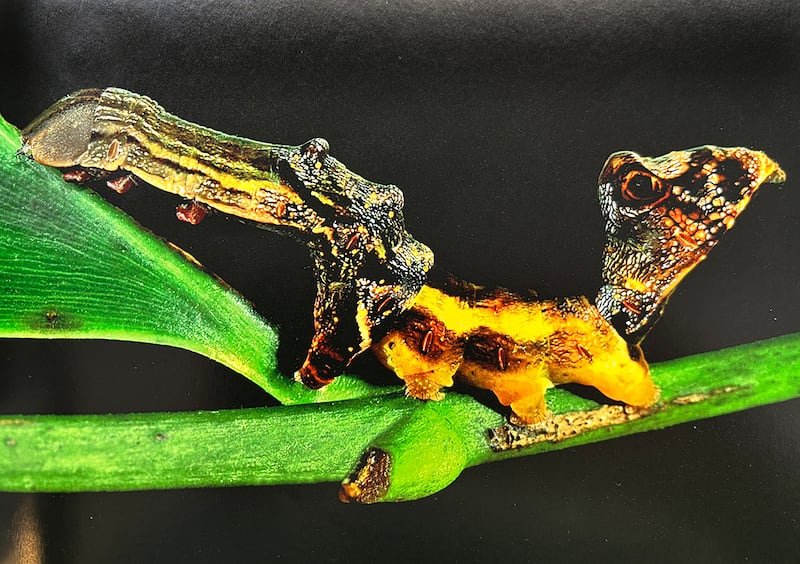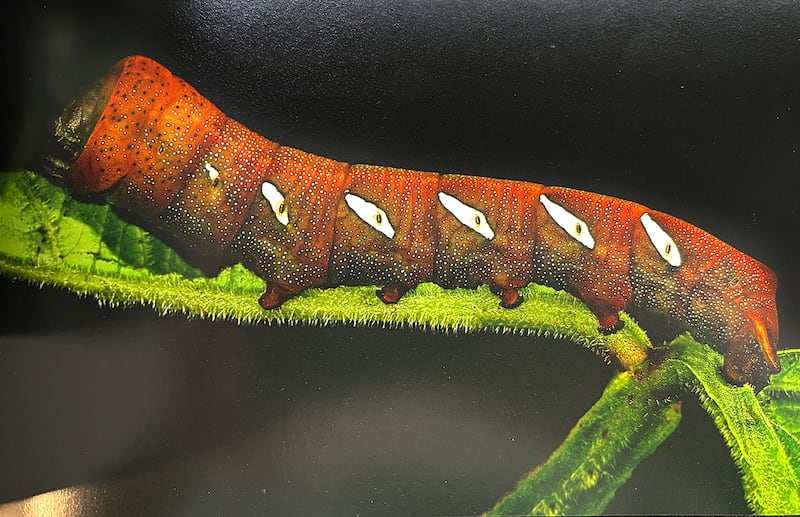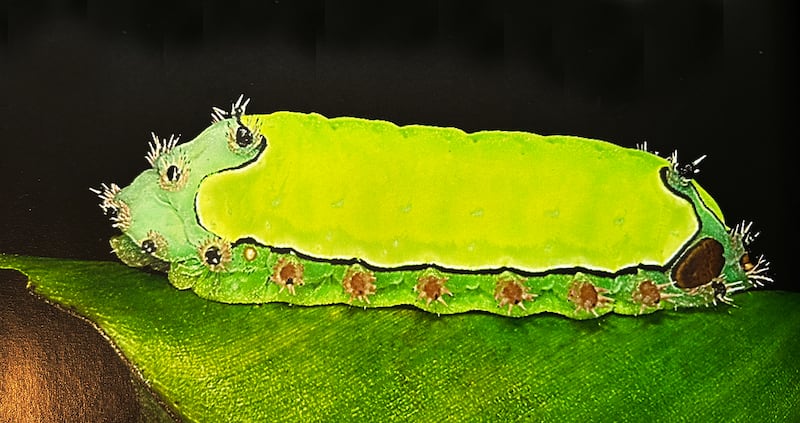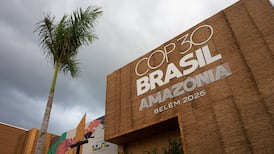“Thanks for coming to see our all our bugs,” Daniel Janzen and Winifred Hallwachs wrote to me on the dedication page of 100 Caterpillars, their exquisitely detailed photographic study with Jeffrey C Miller published in 2006.
I had just been researching their very large-scale nature restoration site, Área de Conservación Guanacaste (ACG), in northwestern Costa Rica in 2011. There is, of course, a great deal more to see in ACG than bugs but, as we shall find out, their huge presence is critical for its ecosystem restoration and conservation.
Their book is lavishly illustrated with breathtaking portraits of unlikely “bugs” in “a life stage that abounds with the beauty of nature”. Butterflies may grab our attention much more easily but, close up, these tropical caterpillars are marvels of bio-design. The book also celebrates an ecological achievement, ACG’s return to most of its enormous pre-agricultural biodiversity, and its intimate linkage to insect life.
So it’s a sad irony that, a decade later, Janzen and Hallwachs find themselves writing and talking about catastrophic population crashes (up to 80 per cent in species’ richness and biomass) in the populations of spiders and insects, including caterpillars, in the reserve’s tropical dry forest. They believe these crashes are direct outcomes of climate change. Vertiginous collapses in insect populations have been increasingly observed across the world. A groundbreaking 2018 report found that flying insects had fallen by 75 per cent in just 27 years in 63 nature reserves across Germany.
READ MORE
The ACG is special because of the number of distinctive ecosystems it encompasses: 1,690sq km of dry tropical forest, tropical rainforest, cloud forest and volcanic summits, plus an entire Pacific coastal and marine reserve.
Its biodiversity also reaches almost unimaginable scales compared with the northern hemisphere: “There are as many species within 50km of our [forest] dwelling in northwestern Costa Rica as in all Europe or half North America,” says Janzen.
Bugs are not just bizarre sideshows in the park’s bio-drama. They consume (or used to) millions of tonnes of foliage annually, while as butterflies and moths they pollinate some 10,000 plant species. So insects play a key role in plant interactions, as well as the food chain.

A crash in insect populations, therefore, has severe effects on overall biodiversity. And what Janzen and Hallwachs have observed, personally and through their small army of local, informally trained “parataxonomists”, is shocking. Over the past 30 years, the rainy season, once regular almost to the day, now fluctuates by months. The intense dry season has increased from four months to six. The impact is devastating. Forests that once showed traces of insect life on every leaf often now appear “fumigated”, they say, with barely a sign of foliage consumption, nests or eggs.
[ Insects are essential for life but they need to be protectedOpens in new window ]
“We are losing most of the insect community that remains in the cloud forests due to the drying of the tops of tropical mountains, just as we are losing the huge biomass of insect communities that once occupied the fertile soils, weather and water of the lowland tropics,” they write.
Insects have been patchily driven from these lowlands by agricultural practices for centuries, but the impact of human-driven climate change is much more thorough and long-lasting. The park’s forests were quite quickly restored from species-poor pasture through fire suppression. And Janzen and Hallwachs had been pleased to find that insects quickly recolonised areas they had previously had to abandon due to pesticides and pasture creation. But when insects abandon areas due to climate change, they are much less likely to be able to return to old haunts, where the new vegetation “looks like a pesticides greenhouse”.
“An outstanding trait of climate change,” they wrote in 2021, “is that to an ever-increasing degree the “previous” no longer exists. A 200-year-old tree with all its attendant portions of thousands of ecosystem webs now and during its lifetime, now subject to climate change, no longer has the climate or interactors with which to reproduce itself the way its parents did.”
“The house is burning,” Janzen says. “We don’t need a more sophisticated thermometer, we need a fire hose.”
What might that fire hose be, what hope can there be for the return of insect populations and diversity to the park? Janzen and Hallwachs advocated an idiosyncratic and daring approach to the problem.
A key element in the initial and continuing success in the park has been the enlistment of the activities of neighbouring people, not just in traditional tasks of protection and restoration, but in reading and recording the biodiversity “library” the park encompasses.

From a very early stage, the park employed resident “parataxonomists” to collect, identify and monitor insects. Janzen and Hallwachs argue that such work has a double function: it obviously broadens and deepens our understanding of the park’s biodiversity. But it also gives local people a sense of pride and ownership of this vast array of species. We tend to value and conserve only that which we can recognise and name.
Paradoxically, they argue, unless citizens everywhere treat wild nature with the love and respect they give their own gardens, the wildlands have no future in our overpopulated world.
“Part of the problem is in the name,” they say. “Stop labelling the wild as the wild. There are simply many varieties of gardens. There is no human-footprint-free world.”
So conservationists must stop presenting nature as something separate to be preserved solely in splendid isolation for its own sake. Instead, the human genome itself, Janzen and Hallwachs argue ambitiously, needs to expand its sense of its own extent and needs, from our limited perspective today, to include all of nature. In short, this means we would see rich biodiversity as vital to our own survival; otherwise we will inevitably destroy the natural world.
Parataxonomy in the park itself was conceived as just the start of persuading many Costa Ricans that wildland nature is indeed an essential and valued part of their human heritage, and not simply a source of scarce resources. Its local success persuaded successive post-1985 Costa Rican governments to make “bioliteracy” (the BioAlfa programme) an essential part of its education system, so that children and citizens across the country began systematically exploring the diversity of life on their doorsteps.

A key aid in this revolutionary project was the rapid advance in genetic barcoding, which enables a species to be reliably identified from a fragment of its body parts through “scanning” its unique DNA sequences. Schools trapped insects and sent them to a special barcoding facility at the University of Guelph, Canada, which identified what they found, some new to science.
Sadly, however, the national BioAlfa project suffered a severe and perhaps fatal setback in 2022 when the current populist president Rodrigo Chaves was elected. He has taken the country in an anti-environment direction parallel to Argentina’s trajectory, and the project really only continues in ACG today.
Janzen and Hallwachs have placed great faith in using this system to make citizens treasure their country’s natural wealth, and to engage with combating the climate change that is destroying it. It can, they say, “reinforce a national attitude that is willing to keep its carbon out of the air, grow forest back on lands that once were cattle pastures, and keep its natural wild capital alive”.
It is a very long shot, and the odds against it are huge. But it is arguably more hopeful than any other national conservation programme yet conceived. Ireland’s education system, and civil society, could learn a lot from it. The National Biodiversity Data Centre concedes that monitoring of Irish insect populations is still in its infancy.
Here, too, their loss is having drastic negative impacts, often still undetected, on the wild gardens of our natural systems. Perhaps it’s time to take bugs into the heart of our Irish genomes while we can still find even a few of them splattered on our windscreens after a country drive.
Paddy Woodworth’s book Our Once and Future Planet (Chicago 2015) includes a chapter on the restoration of ACG
- Sign up for push alerts and have the best news, analysis and comment delivered directly to your phone
- Join The Irish Times on WhatsApp and stay up to date
- Listen to our Inside Politics podcast for the best political chat and analysis
















